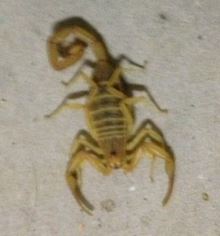In Arizona, the bark scorpion ( Centruroides exilicanda and Centruroides sculpturatus) is the most common type of scorpion. These insects hide during the scorching daytime temperatures then come out at night to hunt. They sting their prey with their tails, injecting a potent venom.

Scorpion venom contains a potent neurotoxin that can cause disorientation, hypertension, paralysis, convulsions, excessive tearing and salivation, muscle fasciculation and even contortions. Animals who have been stung by a bark scorpion also cough. I am not sure why this occurs but the cough helps me make the diagnosis. I read an account of one veterinarian who was stung on the finger by a bark scorpion. He said his throat felt like it was full of grit. Perhaps the animals are experiencing the same thing.
Treatment for scorpion stings is primarily symptomatic which means treating the symptoms as they occur. Most pets require medication to control pain, seizures and hypertension. Some animals will have severe muscle spasms. I saw a marmoset monkey that had a bad habit of eating scorpions. This little monkey had full body contortions that started with her face and spread backward. There is an antivenin designed for children that also works in animals. The monkey I mentioned made a complete recovery about 20 minutes after receiving the anitvenom although she slept a lot for the next day and seemed stiff.
Besides using the venom to catch food, scorpions also use it for defense. The venom is extremely painful to most mammals. Once injected, it attaches to sodium channels of the nervous system that transmit pain. Grasshopper mice have a modification to their sodium channels that blocks this from occurring allowing them to feast on scorpions. If stung, they might groom the area but are otherwise unharmed. I obviously need to get grasshopper mice for my garage where this scorpion was found!
Sources: -Johnson, Jay. Scorpion Envenomation and Treatment in Chelonia, Association of Exotic mammal Veterinarians Conference 2013. -Rowe, Ashlee, et al, Voltage-gated sodium channel in grasshopper mice defends against bark scorpion. Science Oct. 2013; 342 (6157):441-6. -Shell, Linda. Scorpion Envenomation, Canine Associate Database, Vin 6/5/2010.